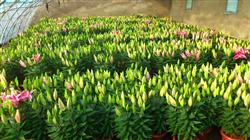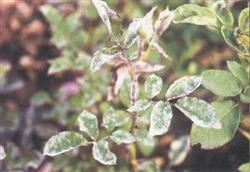Introduction: planting of lilies

Recently, some netizens left a message to us saying: You have edible lily planting and pest control here, how do you not have flower lily planting technology? So now add: Lily is a lily plant of Liliaceae. Excellent both in medicine and food, bulbs for food or medicine. It has the function of nourishing yin and moistening lung, clearing heart and calming nerves. Lily likes warm and humid environment, and grows poorly in high temperature areas. Love dry, afraid of waterlogging. Excessive soil moisture causes bulbs to rot and die. The soil requirements are not strict, but in the deep soil layer, fertile loose sandy loam, bulb color white, thick meat. It grows well on plots of semi-yin and semi-yang, slightly acidic soil. Thick soil is not suitable for cultivation. The root system is robust and developed, and tolerant of fertilizer. After spring, sufficient nitrogen nutrition and enough phosphorus and potassium fertilizer are required, N: P: K=1: 0.8: 1, and the fertilizer should be mainly organic fertilizer. Avoid continuous cropping, 3-4 annual rings for a time, before the leguminous, gramineous crops as well. 1. Land selection and preparation: Should choose fertile soil, high relief, good drainage, loose soil sandy loam cultivation. Combined with soil preparation, 2000 kg organic fertilizer and 40-50 kg Yangfeng compound fertilizer are applied per mu as base fertilizer. Apply 50-60 kg lime (or 50% dianon 0.6 Kg) per mu for soil disinfection. Then fine harrow flat for width 1.3m each ridge or flat ridge, ridge width 30cm, around the deep drainage ditch, good drainage. 2. Lily planting method: Lily is propagated mainly by seed bulbs. Select the bulb with compact scales, white color, no damage, no diseases and insect pests as seed. soak lily seed stem in 70% thiophanate-methyl, carbendazim or agricultural streptomycin solution for 15-30 min for disinfection, air drying, and seeding. The best time is from late September to October. On the whole ridge surface, open transverse grooves according to the row spacing of 25cm, deep grooves of 12cm, and then put in a small bulb every 15cm (plant spacing), with the top upward, cover with fine soil, plant tightly, cover with soil, add a layer of fallen leaves or straw to prevent freezing and moisture, gently compact the leaves and grass, and remove them when they germinate. 1- 15,000 plants per mu, seed consumption per mu 150-200/kg. 3. Lily field management: 1) Early management. In winter, choose sunny days for intertillage, drying topsoil, preserving moisture and heat preservation. Soak soil and weed before emergence in spring, improve ground temperature, promote seedling early development; cover grass to preserve moisture. Summer should prevent high temperature caused by decay; cool days and insulation, frost prevention, and application of seedling fertilizer to promote lily growth. (2) Middle and late management. One is to clear the ditch and drain water. The second is to hit the top in time. The best time is: when the flower bud from vertical to drooping, the color from the full green to the sunny side appears pink. The time is June. Third, control nitrogen fertilizer application after topping. To promote rapid hypertrophy of young bulbs. Before and after the summer solstice should be removed in time, clear ditch moisture, in order to reduce field temperature and humidity. (3) Topdressing. The first time is to apply wax fertilizer steadily. When lily seedlings are not unearthed in January, urea 5-10 kg is applied in combination with intertillage to promote new roots. The second time is to apply strong seedling fertilizer again. In early April, when the height of lily seedlings is 10-20cm, Yangfeng compound fertilizer 10-15 kg and urea 5-10 kg are applied per mu to promote strong seedling. The third time is to apply proper bulb expansion fertilizer. In the first and middle of June, after flowering and topping, apply Yangfeng 48% urine-based compound fertilizer 30-40 kg per mu to promote bulb hypertrophy. At the same time, 0.2% potassium dihydrogen phosphate was sprayed on the leaves. This topdressing should be done 40-50 days before digging. 4. Lily pest control (1)Lily blight: Phytophthora blight is one of the common diseases of lily. It occurs seriously in rainy years, which causes stem and leaf corruption and seriously affects bulb yield. Pathogens can attack stems, leaves, flowers and scales. After the base of the stem is killed, it shrinks like water, causing the whole plant to wither rapidly and die. The leaf is diseased, the disease spot is water-stained, light brown, assumes the irregular big spot. When the disease is serious, flowers, pedicels and scales can be killed, resulting in discoloration and corruption of the disease. The method for preventing and controlling epidemic diseases comprises the following steps of: (1) carrying out rotation;(2) selecting plots with good drainage and loose soil for cultivation;(3) sterilizing seed balls;(4) strengthening field management, paying attention to ditching and drainage; increasing phosphorus and potassium fertilizer to make seedlings grow healthily;(5) spraying 1∶2∶200 bordeaux solution once before emergence, spraying 50% carbendazim 800 times solution 2-3 times after emergence to protect seedlings; pulling out diseased plants in time after occurrence, and treating with 50% quicklime. (2)Lily virus disease: Lily virus infected plants showed yellow leaves or yellow spots, yellow stripes, acute defoliation, poor growth and atrophy. The flower bud wilts and cannot open, and when it is serious, the plant withers and dies. Virus disease control methods: ① breeding disease-resistant varieties or disease-free bulb propagation;② strengthening field management, properly increasing phosphorus and potassium fertilizer, making plants grow strong and enhance disease resistance;③ pulling out seriously damaged plants, preventing aphids as soon as possible, reducing re-infection of aphids with virus. (3)Lily leaf blight and soft rot: Lily leaf blight and soft rot were the main diseases in growing season and storage period respectively. Lily leaf blight and soft rot control method: select healthy, disease-free seed ball propagation, before sowing with 50% benzimidazole 500-600 times solution soaking for 20-30 minutes, drying after sowing. Harvesting and shipping as far as possible do not bruise bulbs, pay attention to ventilation and cooling during storage. (4) Common pests of lily: Lily common pests are aphids, beetle larvae, mites. Aphids harm, often clustered in the tender leaves and buds to absorb juice, so that plant atrophy, poor growth, flowering and fruiting are affected. Lily pest control methods: (1) Clean the countryside, eradicate weeds in the field and reduce the number of overwintering insects;(2) spray 2000 times solution of chrysanthemum resin, or 1500 times solution of 40% omethoate, or 1000 times solution of 50% malathion, aphids, and great meritorious service during the occurrence period. Scarab larvae available malathion, zinc thiophos. Mites can be used acaricides. IV. Harvesting and processing From late July to early August, when the plant shoots wither and the bulbs are fully mature, the sunny days are selected for harvesting. After harvest, remove the aboveground parts, fibrous roots and seed roots, and store them in a ventilated place. The lily for seed had better be left in the field, and when sowing in autumn, it should be dug, selected and sown. It can also be collected after a little drying, with dry sand layer up for later use. Click for more lily planting techniques Click for more flower planting techniques
- Prev

What is eucalyptus special fertilizer?
What is eucalyptus special fertilizer? Please introduce different eucalyptus special fertilizer, referred to as eucalyptus fertilizer, eucalyptus fertilizer is mainly aimed at the rapid growth of eucalyptus, fast nutrient cycle in the forest, high demand for soil nutrients, and according to the general lack of boron, zinc and other trace elements in the soil of southern China. The difference between eucalyptus fertilizer and ordinary compound fertilizer is.
- Next

Rose culture: what is rose powdery mildew? How to cure it?
What is rose powdery mildew? How to cure it? Please introduce that the powdery mildew of rose is caused by the pathogen infecting the leaves, floral organs, tender shoots and so on. In early spring, the leaves of the diseased buds are covered with white powder on both sides. The leaves shrunk and became thicker, and then gradually dried up and died, which became the source of primary infection. The leaves of the growing season.
Related
- Fuxing push coffee new agricultural production and marketing class: lack of small-scale processing plants
- Jujube rice field leisure farm deep ploughing Yilan for five years to create a space for organic food and play
- Nongyu Farm-A trial of organic papaya for brave women with advanced technology
- Four points for attention in the prevention and control of diseases and insect pests of edible fungi
- How to add nutrient solution to Edible Fungi
- Is there any good way to control edible fungus mites?
- Open Inoculation Technology of Edible Fungi
- Is there any clever way to use fertilizer for edible fungus in winter?
- What agents are used to kill the pathogens of edible fungi in the mushroom shed?
- Rapid drying of Edible Fungi

